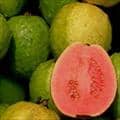Top 10 Fruits Highest in Magnesium

Magnesium is an essential mineral required by the body for muscle and nerve function, maintaining heart rhythm, building strong bones, and energy production. (1,2,3)
Magnesium is an electrolyte, and a deficiency in magnesium can lead to numbness, abnormal heart rhythms, coronary spasms. (4) In the long term, magnesium deficiency increases the risk of stroke, Alzheimer's disease, Parkinson's disease, and migraine. (5)
Fruits are high in fiber and are also a very good source of potassium in addition to magnesium.
Fruits high in magnesium include dried figs, avocados, guavas, bananas, kiwi fruit, papayas, blackberries, raspberries, cantaloupes, and grapefruit. The daily value (DV) for magnesium 420mg per day. (6,7)
Below are the top 10 fruits highest in magnesium. For more, see the extended list of less common fruits rich in magnesium, high magnesium vegetables, and the article on high magnesium foods.
List of Fruits High in Magnesium
 1 Dried Figs
1 Dried Figs| Magnesium 1 Cup | Magnesium per 100g | Magnesium per 200 Calories |
|---|---|---|
| 101mg (24% DV) | 68mg (16% DV) | 55mg (13% DV) |
More Dried Fruit High in Magnesium
- 21% DV per cup of prunes
- 19% DV per cup of apricots
- 16% DV per cup of dates
- 15% DV per cup of zante currants
- 14% DV per cup of raisins
 2 Avocados
2 Avocados| Magnesium per Avocado | Magnesium per 100g | Magnesium per 200 Calories |
|---|---|---|
| 58mg (14% DV) | 29mg (7% DV) | 36mg (9% DV) |
 3 Bananas
3 Bananas| Magnesium per Cup Sliced | Magnesium per 100g | Magnesium per 200 Calories |
|---|---|---|
| 41mg (10% DV) | 27mg (6% DV) | 61mg (14% DV) |
 4 Guavas
4 Guavas| Magnesium per Cup | Magnesium per 100g | Magnesium per 200 Calories |
|---|---|---|
| 36mg (9% DV) | 22mg (5% DV) | 65mg (15% DV) |
 5 Kiwifruit
5 Kiwifruit| Magnesium per Cup | Magnesium per 100g | Magnesium per 200 Calories |
|---|---|---|
| 31mg (7% DV) | 17mg (4% DV) | 56mg (13% DV) |
 6 Papaya
6 Papaya| Magnesium per Cup | Magnesium per 100g | Magnesium per 200 Calories |
|---|---|---|
| 30mg (7% DV) | 21mg (5% DV) | 98mg (23% DV) |
 7 Blackberries
7 Blackberries| Magnesium per Cup | Magnesium per 100g | Magnesium per 200 Calories |
|---|---|---|
| 29mg (7% DV) | 20mg (5% DV) | 93mg (22% DV) |
 8 Raspberries
8 Raspberries| Magnesium per Cup | Magnesium per 100g | Magnesium per 200 Calories |
|---|---|---|
| 27mg (6% DV) | 22mg (5% DV) | 85mg (20% DV) |
 9 Cantaloupe
9 Cantaloupe| Magnesium per Cup | Magnesium per 100g | Magnesium per 200 Calories |
|---|---|---|
| 21mg (5% DV) | 12mg (3% DV) | 71mg (17% DV) |
 10 Grapefruit
10 Grapefruit| Magnesium 1 Cup Sections | Magnesium per 100g | Magnesium per 200 Calories |
|---|---|---|
| 21mg (5% DV) | 9mg (2% DV) | 43mg (10% DV) |
Printable One Page Sheet

Even More Magnesium Rich Fruits
| Food | Serving | Magnesium |
|---|---|---|
| 1 Prickly Pears | per cup | 30% DV (127mg) |
| 2 Plantains | 1 cup mashed | 20% DV (82mg) |
| 3 Passion-Fruit (Granadilla) | per cup | 16% DV (68mg) |
| 4 Breadfruit | 1 cup | 13% DV (55mg) |
| 5 Jackfruit | 1 cup sliced | 11% DV (48mg) |
| 6 Sapodilla | 1 cup pulp | 7% DV (29mg) |
| 7 Mulberries | per cup | 6% DV (25mg) |
| 8 Strawberries | per Cup | 5% DV (22mg) |
| 9 Watermelon | per cup | 4% DV (15mg) |
| 10 Rhubarb | per cup | 3% DV (15mg) |
How Much Magnesium Do You Need Everyday?
The daily value (%DV) for Magnesium is 420mg and is a general target intended for most people. The Recommended Daily Allowance (RDA) shows specific targets by age and gender. The RDA for magnesium is between 300mg - 420mg for most people. (7)
| Life Stage | RDA |
|---|---|
| Children | |
| 1-3 years old | 80mg |
| 4-8 years old | 130mg |
| Males | |
| 9-13 years old | 240mg |
| 14-18 years old | 410mg |
| 19-30 years old | 310mg |
| 31-70 years old | 420mg |
| 70+ years old | 420mg |
| Females | |
| 9-13 years old | 240mg |
| 14-18 years old | 360mg |
| 19-30 years old | 310mg |
| 31-70 years old | 320mg |
| 70+ years old | 320mg |
| Pregnancy | |
| 14-18 years old | 335mg |
| 19-30 years old | 290mg |
| 31-50 years old | 300mg |
| Lactation | |
| 14-18 years old | 400mg |
| 19-30 years old | 350mg |
| 31-50 years old | 360mg |
About the Data
Data for the curated food lists comes from the USDA Food Data Central Repository.
You can check our data against the USDA by clicking the (Source) link at the bottom of each food listing.
Note: When checking data please be sure the serving sizes are the same. In the rare case you find any difference, please contact us and we will fix it right away.
About Nutrient Targets
Setting targets can provide a guide to healthy eating.
Some of the most popular targets include:- Daily Value (%DV) - The daily value (%DV) is a general guideline for consumption that will prevent deficiency of a particular nutrient in most people. The %DV refers to the percentage of an amount that's found in a single serving of a food. It also accounts for absorption factors. It is set by the U.S. FDA.
- Recommended Dietary Allowance (%RDA) - The RDA sets an average daily dietary intake level that is sufficient to meet the nutrient requirements of nearly all (97.5%) healthy individuals. It's more specific than the daily value, and varies by age and gender. The RDA is set by the US National Instutites of Health.
- Reference Dietary Intake (%RDI) -The reference dietary intake is similar to the recommended daily allowance, but is specific to age and gender. The RDI for amino acids is set by the U.N. World Health Organization.
- Adequate Intake (%AI) - This value is primarily used in reference to omega-3 and omega-6 fats. The Adequate Intake is set by the U.S. Institute of Medicine. Because there is less evidence to determine the ideal targets for consumption of these nutrients, the specific amount is considered to be less reliable. Using the term Adequate Intake, rather than one of the other terms, helps to emphasize that the ideal intake of that particular nutrient has not yet been scientifically determined.
See the Guide to Recommended Daily Intakes for more information.
Want to set your own targets? Sign up for an account and set custom targets in the daily meal planner.From the Nutrient Ranking Tool
Use the ranking tool links below to select foods and create your own food list to share or print.
- Foods High in Magnesium
- Foods Low in Magnesium
- Vegetables High in Magnesium
- Fruits High in Magnesium
- Vegetarian Foods High in Magnesium
- Nuts High in Magnesium
- Grains High in Magnesium
- Beans High in Magnesium
- Dairy High in Magnesium
- Breakfast Cereals High in Magnesium
- Fast Foods High in Magnesium
View more nutrients with the nutrient ranking tool, or see ratios with the nutrient ratio tool.
Related
Data Sources and References
- Limaye CS, Londhey VA, Nadkart MY, Borges NE. Magnesium and Human Health: Perspectives and Research Directions J Assoc Physicians India. 2011 Jan;59:19-22. 21751660
- Robertson SP, Johnson JD, Potter JD. Magnesium and the regulation of muscle contraction Biophys J. 1981 Jun;34(3):559-69. doi: 10.1016/S0006-3495(81)84868-0. 7195747
- Robertson SP, Johnson JD, Potter JD. Magnesium and the regulation of muscle contraction Biophys J. 1981 Jun;34(3):559-69. doi: 10.1016/S0006-3495(81)84868-0. 7195747
- Rude RK. Clinical manifestations of magnesium deficiency Endocrinol Metab Clin North Am. 1993 Jun;22(2):377-95. 8325293
- Kirkland AE, Sarlo GL, Holton KF. The Effect of Magnesium Deficiency on Neurological Disorders: A Narrative Review Article Nutrients. 2018 Jun 6;10(6):730. doi: 10.3390/nu10060730. 29882776
- U.S.FDA - Daily Value on the New Nutrition and Supplement Facts Labels
- Institute of Medicine (US) Food and Nutrition Board. Dietary Reference Intakes for Calcium, Phosphorus, Magnesium, Vitamin D, and Fluoride Washington (DC): National Academies Press (US); 1998. 20845565
Try the recipe nutrition calculator, or daily meal planner.
Create a free account to log and track foods.

